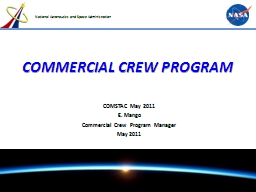

E Mango Commercial Crew Program Manager May 2011 Program Approach The 2010 NASA Authorization Act established commercial crew as the primary means for ISS crew transportation The program objective is to facilitate the development of a US commercial crew space transportation capability for ID: 1042189
Download Presentation The PPT/PDF document "COMMERCIAL CREW PROGRAM COMSTAC May 2011" is the property of its rightful owner. Permission is granted to download and print the materials on this web site for personal, non-commercial use only, and to display it on your personal computer provided you do not modify the materials and that you retain all copyright notices contained in the materials. By downloading content from our website, you accept the terms of this agreement.
1. COMMERCIAL CREW PROGRAMCOMSTAC May 2011E. MangoCommercial Crew Program ManagerMay 2011
2. Program ApproachThe 2010 NASA Authorization Act established commercial crew as the primary means for ISS crew transportation.The program objective is to facilitate the development of a U.S. commercial crew space transportation capability for achieving safe, reliable, and cost effective access to and from LEO and the International Space Station (ISS) by late 2016. Use a non-traditional acquisition and partnering approachCompetition is a fundamental aspect of the strategyNASA could purchase commercial services to meet its ISS crew transportation needs2011201220132014201520162017201820192020MissionsDemo/Test FlightsCommercial CrewFiscal YearCertificationCritical DesignInitial Design
3. Commercial Crew Program (CCP)Kennedy Space Center will host the program office dedicated to enabling commercial human spaceflight capabilities.Program Manager will reside at KSCDeputy Program Manager located at JSCProgram MissionManage the investment in the development of end-to-end transportation systemsManage the CTS (Crew Transportation System) certification processLead the technical and programmatic partner integration and approval functions CCP is leading NASA’s efforts to develop an American-made commercial capability for crew transportation and rescue services to the station following this year's retirement of the space shuttle fleet.
4. Phase 1 Initial Design ConceptsCommercial Crew Development
5. Phase 2 Maturing Design ElementsCommercial Crew Development
6.
7. FAA CollaborationNASA/FAA collaboration is already underwayRotational assignment for CCP representative at FAA headquartersFAA representative at CCP Office at KSCSupporting the planning for the FAA/AST Technical Center at KSCNASA is supporting FAA definition of regulations for crew and participant safetyFAA is participating in CCP safety certification requirements developmentBoth Agencies are ensuring compatibility between NASA requirements and FAA regulationsFAA participates in CCP milestone reviews
8. Agency MissionsDiffering Agency missions lead to different priorities and approachesNASA:Customer and Partner for Design, Certification and ServicesResponsibility for the safety of its crewsMission success requirements beyond crew safetyFAA:Regulator Agency Promotes new, broad and varied industry interestsMust allow the industry to developCurrent focus on the safety of public and spacecraft occupants
9. Role of FAA LicensingFAA Licensed missions for CCP is desired stateNASA and FAA must ensure public safety and crew safety are balancedCollaboration efforts in full swing between CCP and FAA/ASTRequires verification that FAA regulations are compatible with NASA requirementsDevelopment of criteria for ensuring safe and smooth licensing approachMust involve collaboration between NASA and the FAA to enable licensing of launches and entries that:Facilitates appropriate allocation of liability/risk between Government and Commercial Partner (CP)Eliminates duplicate and conflicting Government requirements imposed on CPTakes maximum advantage of both NASA and FAA knowledge and experience9
10. Guiding ConsiderationsAssurance of Public Safety and Crew Safety for NASA-contracted missions must be preservedControls (regulatory or contractual) must provide an effective balance between crew safety and protecting the publicNASA is accountable for crew safetyNASA/FAA will work with the Range and the CP for the appropriate range safety capabilities while working to balance any flight-related risks to crew safetyCriteria for FAA license will be determined and accepted by each AgencyLiability protection for commercial providers can be accommodated either by FAA licensing or NASA contract mechanisms10
11. Program Roadmap NASA CTS CertificationDevelopment/Test MissionsISS Services MissionsTransportation to/from LEOA continued strong NASA and FAA relationship is paramount for all CCP missions. For all missions:NASA collaborates with FAA to transfer knowledge, build expertise, and share resourcesApproach includes increasing FAA Licensing authorityHybridApproachFAA LicensedLaunch/EntryNASA develops contractual requirements for certificationNASA supports FAA development and evolution of regulationsCompatibility between Public Safety and Crew Safety 11 Timing of FAA License approach based on Criteria :Collaboration between NASA and FAA critical to defining Criteria for initial Test and Service Missions
12. Advantages/ChallengesAdvantagesPlanned approach balances Government obligations with advantages to CPsSupports goal to achieve safe commercial human space flightEnables earliest opportunity for FAA license while meeting all safety obligationsMinimizes duplication of processes without compromising crew or public safetyDraws on available Government skills and expertise, regardless of policy and regulatory approach12ChallengesLicensing approach criteria will need close and diligent collaborateTimeframe for FAA regulations governing crew/participant safetyMixed-NASA Crews must also be fully endorsed by the approach
13. SummaryNASA and the FAA are committed to collaborating on a unified approach to ensuring public and crew safetyNASA/FAA already established working relationship and developing MOANASA/FAA are striving for compatibility between NASA requirements and FAA regulationsNASA and the FAA are discussing a overall licensing approach in support of the Program Roadmap Together, NASA and the FAA will enable FAA licensing for NASA crew and non-NASA transportation launches and entries in support of mature Commercial Human Space Flight Operations13